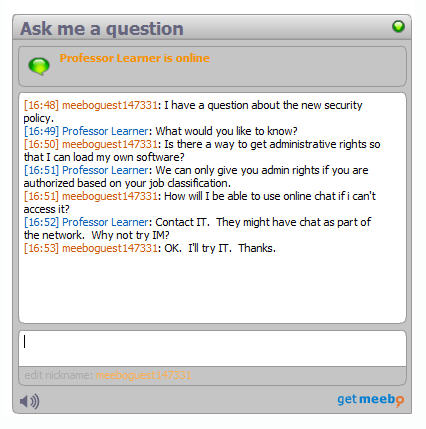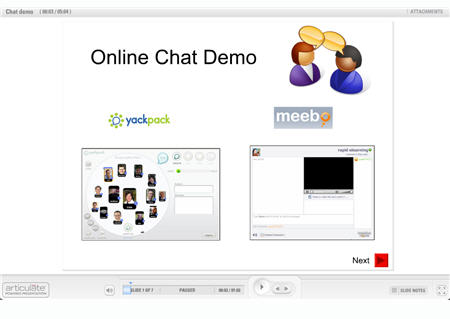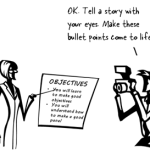I like the idea of adding real time chat to my training. I can see something like this working for non profits. How can this work in a corporate environment?
Get Your Learners Chatting in Your Next E-learning Course
September 24th, 2007
In a recent post, Clark Quinn reminded us that “dialogue is the most powerful learning technology on earth.”
In his excellent book, Informal Learning, Jay Cross discusses the value of conversation as part of our learning process because we all come from unique backgrounds and levels of expertise. This allows us to “draw different implications from [the facts] and engage in new trains of thought.”
One challenge for us in the elearning community is to introduce real conversation into our elearning courses.
In my last post, we looked at the communication process. One of my points was that while we assume that the learners understand the information we share, the reality is that they only understand it from their own context and experience and potentially misunderstand what we are trying to teach.
This proved itself true in the feedback I got from the last post. I used the terms “open and closed loop” to describe the communication process. However, Carl Azar was quick to point out that what I described is the opposite of how those words are used in the engineering community. Thus, my use of “open and closed loop” introduced some confusion.
Because of the comments section, Carl was able to engage me in conversation and offer information that transformed my understanding. This is an excellent example of how dialogue with others enhances our learning experience.
This interaction with Carl and some of the other readers made me think of ways that I could add real conversation to the learning process while using rapid elearning software. Over the next few posts, I’ll introduce some ideas that you might be able to use in your next elearning course to connect the learners and instigate real conversation.
Typically, elearning is designed with independent learning in mind. Thus, we build a course and then have the learner sit in front of the computer and click through the screens. Instead of approaching the elearning this way, why not build the course as a multi learner process? There a few ways to design this type of learning experience.
Have the learners go through a course together rather than by themselves.
Design the elearning course so that two or more learners can participate in it together. Here are two ways where this might work well.
- This approach could be part of a team building process where teammates sit at a computer together and view the course at the same time. To instigate productive conversation, create discussion questions and case studies for them to review and discuss.
- Another possibility is to deliver the elearning course in conjunction with a facilitated session. This allows you to deliver a consistent and controlled message with the structured course content, and then have a break out session where learners can dialogue with each other.
Create an online chat for group discussion.
Creating an online chat is fairly easy to do today. There are many good chat tools available and quite a few of them are free. In addition, many organizations have chat capabilities as part of their technology infrastructure so that you can use an internal chat tool and not have security or access issues.
Here are a couple of ways that you can you use chat to introduce group conversation in your elearning course.
- Create a time where all of the learners take the course together and then participate in a group chat (synchronous). This is especially useful if you have learners in remote locations.
- Instigate chat conversation that is not dependent on a particular time (asynchronous). Many chat programs keep all conversations and maintain the chat as an ongoing transcript so that the information can always be accessed and reviewed by future learners.
Schedule a time where the content expert is available online to answer live questions.
At Articulate, we offer a daily demo, where potential buyers have a live conversation with our sales staff to learn more about our products. Why not use your chat tools to do something similar? Here’s how it could work.
- Have an official time where the learners have live chat access to a subject matter expert to help them and answer questions.
- Instead of a planned activity, just give the learners access to the subject matter expert via chat. The expert is available to answer questions, yet doesn’t have to engage learners unless a question is asked. Below is an image that demonstrates this. I added a Meebo widget to my web page. The learners can see if I am online and ask me questions.

Chat Creates a Dynamic Learning Experience
I created a quick demo to show you how you can use a rapid elearning tool and include the chat feature as part of your learning experience. In my demo, I used Articulate Presenter’s ability to insert web objects. With Presenter, I can insert a web page from my internal network, the Internet, or from my local drive.
Because I can insert web objects, I can augment my elearning content with a web-base chat page. In addition, I can do this with limited technical skills because adding the web object is just a matter of copying and pasting the correct link.
For this demo, I used some of the free chat services available online to give you some ideas about how to use the features in a rapid elearning environment. If you’re looking at the blog post from your organization’s Internet connection, you might not be able to see the chat tools because many organization’s block them.
The benefit to adding chat to your elearning course is that you introduce real dialogue. It’s a great way to stimulate thinking and get past just content delivery. It’s also an excellent way to build better social connection between the learners especially if they are on the same team.
In the next few posts, we’ll look at ways to incorporate other forms of media into the design of your rapid elearning courses.
Events
- Everyday. Check out the weekly training webinars to learn more about Rise, Storyline, and instructional design.
Free E-Learning Resources
 |
 |
 |
|
Want to learn more? Check out these articles and free resources in the community. |
Here’s a great job board for e-learning, instructional design, and training jobs |
Participate in the weekly e-learning challenges to sharpen your skills |
 |
 |
 |
|
Get your free PowerPoint templates and free graphics & stock images. |
Lots of cool e-learning examples to check out and find inspiration. |
Getting Started? This e-learning 101 series and the free e-books will help. |
19 responses to “Get Your Learners Chatting in Your Next E-learning Course”
I can see where this could add a lot of value in the practicum or “put the book learning to use” stage of a course aimed at building specific skills. For example, one could assemble a team that works together and chats not only with each other but also the instructor or a designated advisor in choosing the next step/response in a bargaining simulation.
I think this is a particularly relevant idea for our younger learners (say, in their 20’s)who tend to reach for this kind of chat communication first.
What a great idea. There are some very cool possibilities here. The trick would be to have enough people use the course at the same time and get them talking. I like DennisR’s idea to set up a simulation, have it reach a crisis or major decision point, and then have learners work together to solve the problem. Other approaches could be to put a provocative statement in the course that you know will inspire response, or post the germ of a great idea that will inspire people to brainstorm together.
Hi Tom: Since you have brought the security issue in this article, how do you usually handle it? Do you prefer to insist in using the client infrastructure or rather deliver security compliance yourself?
Thank you in advance.
I’ve used synchronous chat and aynchronous online forums in a course. The one problem I found with chat is managing a group discussion. For example, everyone having the opportunity to speak and receive a response. It seems that chats work better when there are two or three participants; more than that things can get out of hand. Has anyone else had this experience? Any suggestions on managing group chat sessions? Thanks.
Hello everybody !
It’s great to visit this website.
Hi Tom,
i am tring to make some rapid e-content.And you give me lots of idea.
i would like to know if your have any idea to mobile device used by Rapid elearning.
I would be interested in hearing what you say.
Regards
Jack
Thank Tom for your answer. Regarding chats, I recently took an e-course at Universidad de Alcalá (Spain) and it was a huge challenge for teachers and students to coordinate the discussion. Since it was a law course, you can imagine how complex was for the teacher to cope with the all the questions and for us as students to get in the question “queue”. I agree with you and Monique: chats are fine for small groups.
Also do consider the new Google Apps presentations. These have great potential for e-learning as students can create a join presentation and utilise the built-in online chat feature at the same time.
Very useful and immediately accessible for many learners.
Hi
You have got some really nice ideas here.
Cheers
Rupa
Hi Tom. Excellent material here. I’ve been attending an online course which heavily uses chats to make participants work together to prepare papers and other tasks. From the learner’s point of view I can say that it really works and one interesting thing this course I’m doing has, is the module system, and the groups’ components change every module, so after 3 or 4 modules everyone participating in the course has had a chance of getting to know and working together with each other. I just thought it’d be interesting to offer a view from a “customer” rather than a colleague. Thanks again for putting up such a nice blog with so much to offer. All the best.
I’ve just read some of the other comments and want to complement my previous comment: Yes, I do agree with Monique. We’ve had a role-play chat session with all 15 course participants and there were times people were not actually reading what was being posted because of the amount of interventions and because some of the participants couldn´t just cope with so much information. The moderator really had a hard time making some sense out of it all. Nevertheless it was supposed to be a kind of entertainment. The smaller groups (3 to 4 people) dealing with the papers and tasks are working pretty well though. Rgds.
I was just out on the Net looking for a server-side chat script that I could run on my server and tie to members of my own community or course.
I found this: Ajax Chat.
It’s open source and integrates with phpBB, SMF (Simple Machines Forum), and vBulletin.
It seems pretty easy to install and get running (if you know how to set up a database on your server — and if not, your tech-peeps will!)
It could be good if you wanted to run a chat session internally, only for registered members of a course. You could set up the chat client on the company intranet server.
Anyway, that’s all I know about it; I literally just stumbled across it 10 minutes ago and thought I’d add to this post. Hope it’s useful! =)
Leslie










0
comments